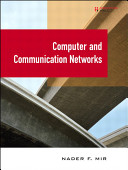Overview of Optical Networks
Optical fibers can transmit digitized light signals over long distances because of the purity of glass fiber combined with improved electronics technology. With some acceptable transmission loss, low interference, and high-bandwidth potential, an optical fiber is almost an ideal transmission medium. Optical communication systems may sometimes be combined with electrical components. In such systems, electrical data bits are converted into light, using a certain wavelength; when the transmission is completed, the optical signal is converted back to an electrical signal, which is then passed to higher layers that manage switching, restoration, and grooming.
Optical networks can provide more bandwidth than regular electronic networks can. Major advantages of partial optical networks are gained by incorporating some electronic switching functions. The optical network shown in Figure 14.1 consists of optical nodes interconnected with physical optical links. A point-to-point physical optical link may consist of several logical paths called lightpaths, each carrying a different wavelength. A lightpath is set up by assigning a dedicated wavelength to it. The data can be sent over the lightpath once it is set up. A lightpath can create virtual neighbors out of nodes that may be geographically far apart in the network. A lightpath uses the same wavelength on all fiber links through which it passes.
Optical networks provide routing, grooming, and restoration of data at the wavelength level and developed from the emergence of the optical layer in the transport and network layers. The challenges of optical networks are network management in the presence of different wavelengths and keeping the cost down to be able to add new services. An optical network's agility gives it the speed and intelligence required for efficient routing. Thereby improving network management and faster connections and network restorations. For an optical system with many channels on a single fiber, a small fiber cut can potentially initiate multiple failures, causing many independent systems to fail.
Notes:
Agile, but requires converting light to electronic signals and vice versa.
Folksonomies: technology optics electronics networking
Taxonomies:
/technology and computing (0.495012)
/science/physics/optics (0.407416)
/technology and computing/networking/network monitoring and management (0.273721)
Keywords:
optical networks (0.976205 (positive:0.500282)), Optical Networks Agile (0.826292 (positive:0.523145)), Optical communication systems (0.765934 (positive:0.284376)), digitized light signals (0.757947 (positive:0.655575)), partial optical networks (0.755911 (positive:0.576270)), improved electronics technology (0.745423 (positive:0.655575)), acceptable transmission loss (0.738484 (negative:-0.317813)), physical optical link (0.736879 (neutral:0.000000)), physical optical links (0.735813 (positive:0.224786)), ideal transmission medium (0.727554 (positive:0.542165)), regular electronic networks (0.711210 (positive:0.466531)), electronic switching functions (0.708851 (positive:0.576270)), electrical data bits (0.705716 (neutral:0.000000)), small fiber cut (0.669605 (negative:-0.530214)), certain wavelength (0.654186 (neutral:0.000000)), network management (0.635827 (positive:0.673638)), different wavelength (0.635254 (neutral:0.000000)), wavelength level (0.622006 (positive:0.364119)), Optical fibers (0.601467 (positive:0.655575)), optical nodes (0.588430 (positive:0.224786)), optical fiber (0.587231 (positive:0.542165)), optical signal (0.573504 (neutral:0.000000)), electronic signals (0.551126 (neutral:0.000000)), long distances (0.550800 (positive:0.655575)), glass fiber (0.550353 (positive:0.655575)), high-bandwidth potential (0.547437 (neutral:0.000000)), optical layer (0.547021 (positive:0.364119)), low interference (0.534989 (negative:-0.460916)), higher layers (0.534836 (positive:0.399651)), network layers (0.529888 (positive:0.364119))
Entities:
Optical Networks Agile:Company (0.915820 (positive:0.523145)), network management:FieldTerminology (0.442529 (positive:0.626611)), communication systems:FieldTerminology (0.265061 (positive:0.284376))
Concepts:
Optical communication (0.976253): dbpedia | freebase
Refractive index (0.895166): dbpedia | freebase
Computer network (0.869902): dbpedia | freebase | opencyc
Optical fiber (0.868296): dbpedia | freebase
Electromagnetic radiation (0.854165): dbpedia | freebase | opencyc
Wavelength (0.851299): dbpedia | freebase
Light (0.845230): dbpedia | freebase | opencyc
Glass (0.803976): dbpedia | freebase | opencyc





